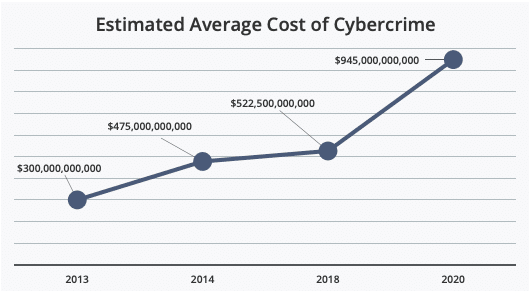Earlier this year we wrote about the fact that cyber attacks cost businesses millions of dollars per incident. But what about the cost of cybercrime on larger scale? This month, McAfee released a new report analyzing at the cost of cybercrime globally, and the findings are staggering.
The most startling news from the report is the jump in the overall cost of cybercrime globally. Between 2018 and 2020, McAfee found a nearly 50% increase in average global cost. Now, the estimated global cost of cybercrime is $945 billion — more than 1% of the global GDP.
Just as startling, however, is that the report found a myriad of additional damages organizations face after a cyber incident beyond direct financial costs. In their report, McAfee found that 92% of organizations surveyed identified “hidden costs” that effected them beyond direct monetary losses. These hidden costs can have long terms effects on an organization’s productivity and ability to prevent future attacks.
One of the main hidden costs the report covers is the “damage to company performance” after a cyber incident. These damages, according to the report, is primarily related to a loss in productivity and lost work hours as businesses attempt to recover from an attack — usually because system downtime and disruptions to normal operations. While these losses might be, to some extent, inevitable following an attack, McAfee’s report found that organizations routinely neglect one essential aspect of cybersecurity: communication within the organizations.
We’ve talked before about the importance of creating an incident response plan, but without communication and cooperation between all areas of an organization, these plans won’t be all that effective. According to the report, IT decision makers think some departments aren’t ever made aware that a cyber incident even happened. The breakdown in communication is especially damaging between IT and business leadership. “IT and line-of-business (LOB) decision makers,” the report says, “have different understandings of what, why, and how a company or government agency is experiencing an IT security incident.” In fact, the lack of communication goes so far as whether or not there is even a response plan at all. The report found that, in general, business leadership often believe there is a response plan in place when there isn’t one.
This lack of communication also extends to the nature and scope of an organization’s cyber risk. The report noted a significant lack of organization-wide understand of cyber risk, which, the report states, “makes companies and agencies vulnerable to social engineering tactics. Once a user is hacked, they do not always recognize the problem in time to stop the spread of malware.”
While there will almost always be disruptions and hidden costs following a cyber incident, McAfee’s report seems to indicate many of these losses are self-inflicted. The report shows that the most common change organizations make after a cyber incident is investment in new security software. And, while technical safeguards are certainly necessary, they are far from sufficient. Instead, organizations need to begin investing in policies and procedures that ensure organization-wide communication, knowledge, and response to cyber risk and incidents.

